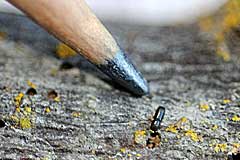This is a brief overview of the black walnut disease called Thousand Cankers. Since there are no confirmed reports of this disease in Illinois this is a precautionary notice.

This disease kills black walnut trees by destroying the phloem thereby stopping the flow of nutrients. It was first described in early 2008 by researchers at Colorado State University, but is thought to have been infecting and killing walnut trees for at least a decade. The disease had only been found in the western United States until July 2010 when an outbreak was confirmed in Knoxville, Tennessee.
Thousand Cankers disease is caused by the fungus Geosmithia (morbida) which is carried by the adult walnut twig beetle. The beetle burrows into a twig carrying the fungus; the fungus forms a canker which expands over time. Each beetle wound causes another canker. As the tree becomes stressed with the expanding cankers, more beetles are attracted. It is death by a thousand cankers.
Because the cankers are buried in the phloem, there is no outward sign of disease. Early yellowing of the exterior crown, followed by leaf wilting of large limbs, marks the end of the tree. Susceptible walnuts die within two or three years of leaf yellowing.
For a more complete description, go to this
Wikipedia article
or the
Colorado State University website
It is possible that the disease has been present for years with researchers just recently able to identify the fungus agent and its relationship with the twig beetle. A proposed theory for the disease origin is that the slow-growing Arizona walnut, which are fairly resistant, harbored the disease. As the eastern black walnut was introduced in western states, it fell prey due to its faster growth.
The disease progresses slowly when introduced into an area, it is thought that the Knoxville infestation may have started over a decade ago. That said, there may be other unreported infections in the eastern US.
Researchers currently do not know how long a tree has to live once infected. It could take more than a decade. Certainly, vigorously growing trees planted on good walnut sites will be more resistant.
There are no known spraying techniques that have been proven to control the walnut twig beetle. But there are two things you can do.
1) Do not bring any walnut wood onto your land - logs, burls, firewood, mulch, or even packing material. The beetle survives on wood for up to 3 years after trees are cut, and can even survive chipping. At present, there are no reports that nursery stock is a vector.
2) Favor dominant, vigorously growing walnuts in your stand management. Walnuts losing the competition with other crop trees or older walnuts exhibiting slower growth could be stressed and therefore susceptible to disease. Consider harvesting them.
Download the USDA Forest Service
Thousand Canker Disease Field Guide.
The video below was provided by the Virginia Department of Agriculture. It is a good overview of the symptoms of this disease and how to spot the walnut twig beetle entry/exit holes and then expose the underlying camkers. The video is a little over five minutes in length.
As of 2/1/2012, the Illinois Department of Agriculture has instituted a ban on movement of walnut products into or through the state. You can read about the specifics of the ban in the third comment below. There are three (3) documents associated with this ban:
a) the Governor's Proclamation -
Download here (279 KB)
b) a description of the disease and its extent -
Download here (2.9 MB)
c) a compliance certificate -
Download here (148 KB)

